Analysis of the Expression of LSF Transcription Factor in the Regulation of Transcription and TSG101 during the Neoplastic Transformation of Endometrial Cells
Abstract
1. Introduction
1.1. Carcinogenesis and Molecular Biology
1.2. Gen TSG101
1.3. LSF Transcription Factor
2. Objective
3. Materials
- Study group: 60 women diagnosed with endometrial cancer;
- Control group: 60 women with benign diseases of the female reproductive organs.
4. Methodology
4.1. Methodology of Immunohistochemical Tests
4.2. Preparation Staining Protocol
4.3. Detection of TSG101 and LSF antigens
- Anti-LSF Purified Monoclonal Mouse IgG1 (clone: 14/LSF) (1:50 dilution) (BD Transduction LaboratoriesTM, Cat. No. 610818, BD Biosciences, North Brunswick Township, NJ, USA);
- TSG101 (C-2): sc-7964 Mouse Monoclonal Antibody (1:50 dilution) (Santa Cruz Biotechnology, Inc., Dallas, TX, USA).
4.4. Immunohistochemical Analysis of TSG101 and LSF Expression
4.5. Qualitative Assessment of TSG101 and LSF Expression
- -
- IS (intensity score): no color reaction (none), weak reaction (weak), and medium reaction (moderate); a strong reaction was not present in any of the preparations;
- -
- Quantity: ranges of 0%, <25% stained cancer cells/normal endometrium, 25–50%, 50–75%, >75%.
4.6. Statistical Analysis
5. Results
5.1. Assessment of the Risk of Developing Endometrial Cancer Depending on the Presence of Specific Variables
5.2. Assessment of Correlations among Selected Markres in the Control and Study Groups
5.3. Assessment of the Diagnostic Usefulness of the Tested Molecular Markers in the Detection of Endometrial Cancer
6. Discussion
6.1. TSG101
6.2. LSF
6.3. LSF and TSG101
7. Conclusions
- A much lower level of TSG101 expression was observed in endometrial cancer than in the non-cancerous endometrium, and it may have utility as a diagnostic marker of endometrial cancer.
- Decreased expression of LSF may be a marker of low-grade endometrial cancer, and increased expression of LSF may indicate progression of the disease and a worse prognosis.
- The effect of the LSF transcription factor on the regulation of TSG101 expression remains unknown, and this issue requires further research.
Author Contributions
Funding
Institutional Review Board Statement
Informed Consent Statement
Data Availability Statement
Acknowledgments
Conflicts of Interest
Abbreviations
| AUC | area under the curve |
| BMI | body mass index |
| DNA | deoxyribonucleic acid |
| EIN | endometrial intraepithelial neoplasia |
| FIGO | French Federation Internationale de Gynécologie et d’Obstetrique (International Federation of Gynecology and Obstetrics) |
| LSF | late simian virus 40 factor (SV40 late transcription factor (synonym: TFCP2)) |
| OR | odds ratio |
| PIK3CA | mutation in breast cancer |
| PTEN | phosphatase and tensin homolog deleted on chromosome ten (protein encoded by the gene suppressor PTEN located on the long arm of chromosome 10) |
| RNA | ribonucleic acid |
| RR | relative risk |
| SV40 | simian virus 40 (monkey virus) |
| TCGA | The Cancer Genome Atlas |
| TSG101 | tumor susceptibility gene 101 |
| WHO | World Health Organization (global health organization) |
References
- Majérus, M.A. The cause of cancer: The unifying theory. Adv. Cancer Biol. Metastasis 2022, 4, 100034. [Google Scholar] [CrossRef]
- Available online: https://usafacts.org/articles/how-have-cancer-rates-changed-over-time/ (accessed on 28 February 2024).
- Kornafel, J.; Mądry, R.; Bidziński, M.; Bręborowicz, J.; Gawrychowski, K.; Łacko, A.; Roszak, A.; Tacikowska, M. Cancers of the female reproductive system. Recommendations for diagnostic and therapeutic procedures in malignant tumors. Pol. Soc. Clin. Oncol. 2013, 12, 1702–1710. Available online: https://basiw.mz.gov.pl/wp-content/uploads/2019/05/onkologiaeng.pdf (accessed on 29 February 2024).
- Torre, L.A.; Bray, F.; Siegel, R.L.; Ferlay, J.; Lortet-Tieulent, J.; Jemal, A. Global cancer statistics, 2012: Global Cancer Statistics, 2012. CA Cancer J. Clin. 2015, 65, 87–108. [Google Scholar] [CrossRef] [PubMed]
- National Cancer Registry. Available online: https://onkologia.org.pl/pl (accessed on 20 January 2024).
- Bokhman, J.V. Two pathogenetic types of endometrial carcinoma. Gynecol. Oncol. 1983, 15, 10–17. [Google Scholar] [CrossRef] [PubMed]
- Cancer Genome Atlas Research Network; Weinstein, J.N.; Collisson, E.A.; Mills, G.B.; Shaw, K.R.; Ozenberger, B.A.; Ellrott, K.; Shmulevich, I.; Sander, C.; Stuart, J.M. The Cancer Genome Atlas Pan-Cancer analysis project. Nat. Genet. 2013, 45, 1113–1120. [Google Scholar] [CrossRef] [PubMed]
- Binder, P.S.; Mutch, D.G. Update on Prognostic Markers for Endometrial Cancer. Womens Health 2014, 10, 277–288. [Google Scholar] [CrossRef]
- Chang, J.G.; Su, T.H.; Wei, H.J.; Wang, J.-C.; Chen, Y.-J.; Chang, C.-P.; Jeng, C.-J. Analysis of TSG101 tumor susceptibility gene transcripts in cervical and endometrial cancers. Br. J. Cancer 1999, 79, 445–450. [Google Scholar] [CrossRef] [PubMed][Green Version]
- Broniarczyk, J.K.; Warowicka, A.; Kwaśniewska, A.; Wohuń-Cholewa, M.; Kwaśniewski, W.; Goździcka-Józefiak, A. Expression of TSG101 protein and LSF transcription factor in HPV-positive cervical cancer cells. Oncol. Lett. 2014, 7, 1409–1413. [Google Scholar] [CrossRef] [PubMed][Green Version]
- Makler, A.; Asghar, W. Exosomal biomarkers for cancer diagnosis and patient monitoring. Expert Rev. Mol. Diagn. 2020, 20, 387–400. [Google Scholar] [CrossRef]
- Jing, L.; Hua, X.; Yuanna, D.; Rukun, Z.; Junjun, M. Exosomal miR-499a-5p Inhibits Endometrial Cancer Growth and Metastasis via Targeting VAV3. Cancer Manag. Res. 2020, 12, 13541–13552. [Google Scholar] [CrossRef] [PubMed]
- Zhou, L.; Wang, W.; Wang, F.; Yang, S.; Hu, J.; Lu, B.; Pan, Z.; Ma, Y.; Zheng, M.; Zhou, L.; et al. Plasma-derived exosomal miR-15a-5p as a promising diagnostic biomarker for early detection of endometrial carcinoma. Mol. Cancer 2021, 20, 57. [Google Scholar] [CrossRef] [PubMed]
- Hu, C.; Jiang, W.; Lv, M.; Fan, S.; Lu, Y.; Wu, Q.; Pi, J. Potentiality of Exosomal Proteins as Novel Cancer Biomarkers for Liquid Biopsy. Front. Immunol. 2022, 13, 792046. [Google Scholar] [CrossRef] [PubMed]
- Fan, J.T.; Zhou, Z.Y.; Luo, Y.L.; Luo, Q.; Chen, S.-B.; Zhao, J.-C.; Chen, Q.-R. Exosomal lncRNA NEAT1 from cancer-associated fibroblasts facilitates endometrial cancer progression via miR-26a/b-5p-mediated STAT3/YKL-40 signaling pathway. Neoplasia 2021, 23, 692–703. [Google Scholar] [CrossRef] [PubMed]
- Kotarba, G.; Krzywinska, E.; Grabowska, A.I.; Taracha, A.; Wilanowski, T. TFCP2/TFCP2L1/UBP1 transcription factors in cancer. Cancer Lett. 2018, 420, 72–79. [Google Scholar] [CrossRef] [PubMed]
- Koskas, M.; Amant, F.; Mirza, M.R.; Creutzberg, C.L. Cancer of the corpus uteri: 2021 update. Int. J. Gynaecol. Obstet. 2021, 155 (Suppl. S1), 45–60. [Google Scholar] [CrossRef] [PubMed]
- Bennett, N.A.; Pattillo, R.A.; Lin, R.S.; Hsieh, C.Y.; Murphy, T.; Lyn, D. TSG101 expression in gynecological tumors: Relationship to cyclin D1, cyclin E, p53 and p16 proteins. Cell. Mol. Biol. 2001, 47, 1187–1193. [Google Scholar] [PubMed]
- Young, T.W.; Mei, F.C.; Rosen, D.G.; Yang, G.; Li, N.; Liu, J.; Cheng, X. Up-regulation of tumor susceptibility gene 101 protein in ovarian carcinomas revealed by proteomics analyses. Mol. Cell Proteom. 2007, 6, 294–304. [Google Scholar] [CrossRef] [PubMed]
- Jiang, Y.; Ou, Y.; Cheng, X. Role of TSG101 in cancer. Front. Biosci. (Landmark Ed.) 2013, 18, 279–288. [Google Scholar] [CrossRef] [PubMed]
- Perri, F.; Longo, F.; Giuliano, M.; Sabbatino, F.; Favia, G.; Ionna, F.; Addeo, R.; Scarpati, G.D.V.; Di Lorenzo, G.; Pisconti, S. Epigenetic control of gene expression: Potential implications for cancer treatment. Crit. Rev. Oncol./Hematol. 2017, 111, 166–172. [Google Scholar] [CrossRef]
- Ferraiuolo, R.M.; Manthey, K.C.; Stanton, M.J.; Triplett, A.A.; Wagner, K.U. The Multifaceted Roles of the Tumor Susceptibility Gene 101 (TSG101) in Normal Development and Disease. Cancers 2020, 12, 450. [Google Scholar] [CrossRef] [PubMed]
- Jiang, H.; Du, J.; Jin, J.; Qi, X.; Pu, Y.; Fei, B. LSF expression and its prognostic implication in colorectal cancer. Int. J. Clin. Exp. Pathol. 2014, 7, 6024–6031. [Google Scholar] [PubMed]
- Li, X.P.; Xu, Q.Y.; Wang, J.L.; Wang, S.J.; Zhao, Y.; Wei, L.H. Evaluation of whether serum tumor markers in patients with epithelial ovarian carcinoma change following chemotherapy. Chin. Med. J. 2012, 125, 410–415. [Google Scholar] [PubMed]
- Goto, Y.; Yajima, I.; Kumasaka, M.; Ohgami, N.; Tanaka, A.; Tsuzuki, T.; Inoue, Y.; Fukushima, S.; Ihn, H.; Kyoya, M.; et al. Transcription factor LSF (TFCP2) inhibits melanoma growth. Oncotarget 2016, 7, 2379–2390. [Google Scholar] [CrossRef] [PubMed]
- Pulling, L.C.; Grimes, M.J.; Damiani, L.A.; Juri, D.E.; Do, K.; Tellez, C.S.; Belinsky, S.A. Dual promoter regulation of death-associated protein kinase gene leads to differentially silenced transcripts by methylation in cancer. Carcinogenesis 2009, 30, 2023–2030. [Google Scholar] [CrossRef] [PubMed]
- Tian, Y.; Bresenitz, P.; Reska, A.; El Moussaoui, L.; Beier, C.P.; Gründer, S. Glioblastoma cancer stem cell lines express functional acid sensing ion channels ASIC1a and ASIC3. Sci. Rep. 2017, 7, 13674. [Google Scholar] [CrossRef] [PubMed]
- Guo, J.; Tong, J.; Zheng, J. Circular RNAs: A Promising Biomarker for Endometrial Cancer. Cancer Manag. Res. 2021, 13, 1651–1665. [Google Scholar] [CrossRef] [PubMed]
- Zhang, J.; Zhao, X.; Zhang, J.; Zheng, X.; Li, F. Circular RNA hsa_circ_0023404 exerts an oncogenic role in cervical cancer through regulating miR-136/TFCP2/YAP pathway. Biochem. Biophys. Res. Commun. 2018, 501, 428–433. [Google Scholar] [CrossRef] [PubMed]
- Yu, W.; Zhang, C.; Wang, Y.; Tian, X.; Miao, Y.; Meng, F.; Ma, L.; Zhang, X.; Xia, J. YAP 5-methylcytosine modification increases its mRNA stability and promotes the transcription of exosome secretion-related genes in lung adenocarcinoma. Cancer Gene Ther. 2023, 30, 149–162. [Google Scholar] [CrossRef]
- Huang, X.; Lai, S.; Qu, F.; Li, Z.; Fu, X.; Li, Q.; Zhong, X.; Wang, C.; Li, H. CCL18 promotes breast cancer progression by exosomal miR-760 activation of ARF6/Src/PI3K/Akt pathway. Mol. Ther. Oncolytics 2022, 25, 1–15. [Google Scholar] [CrossRef] [PubMed]
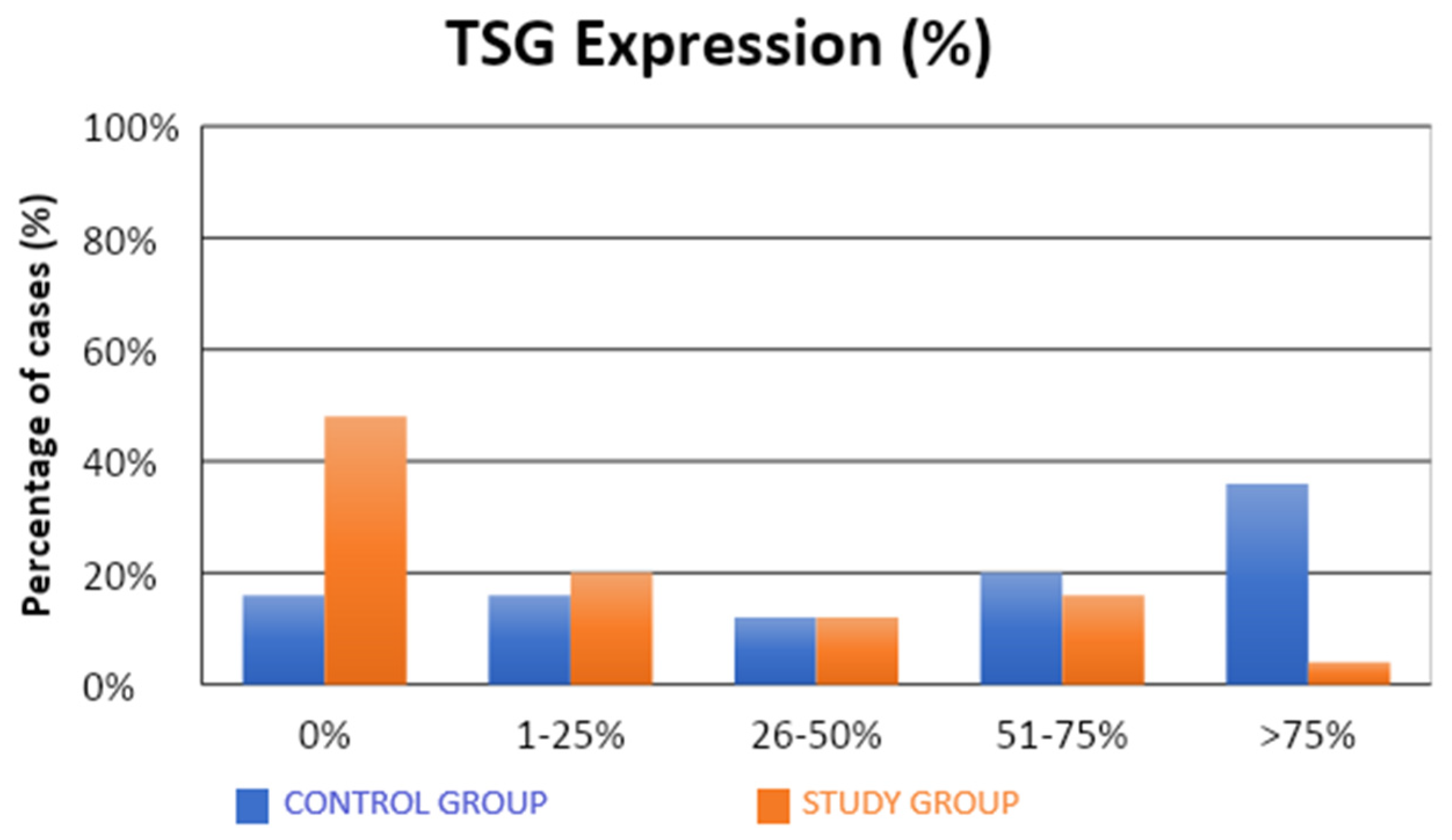
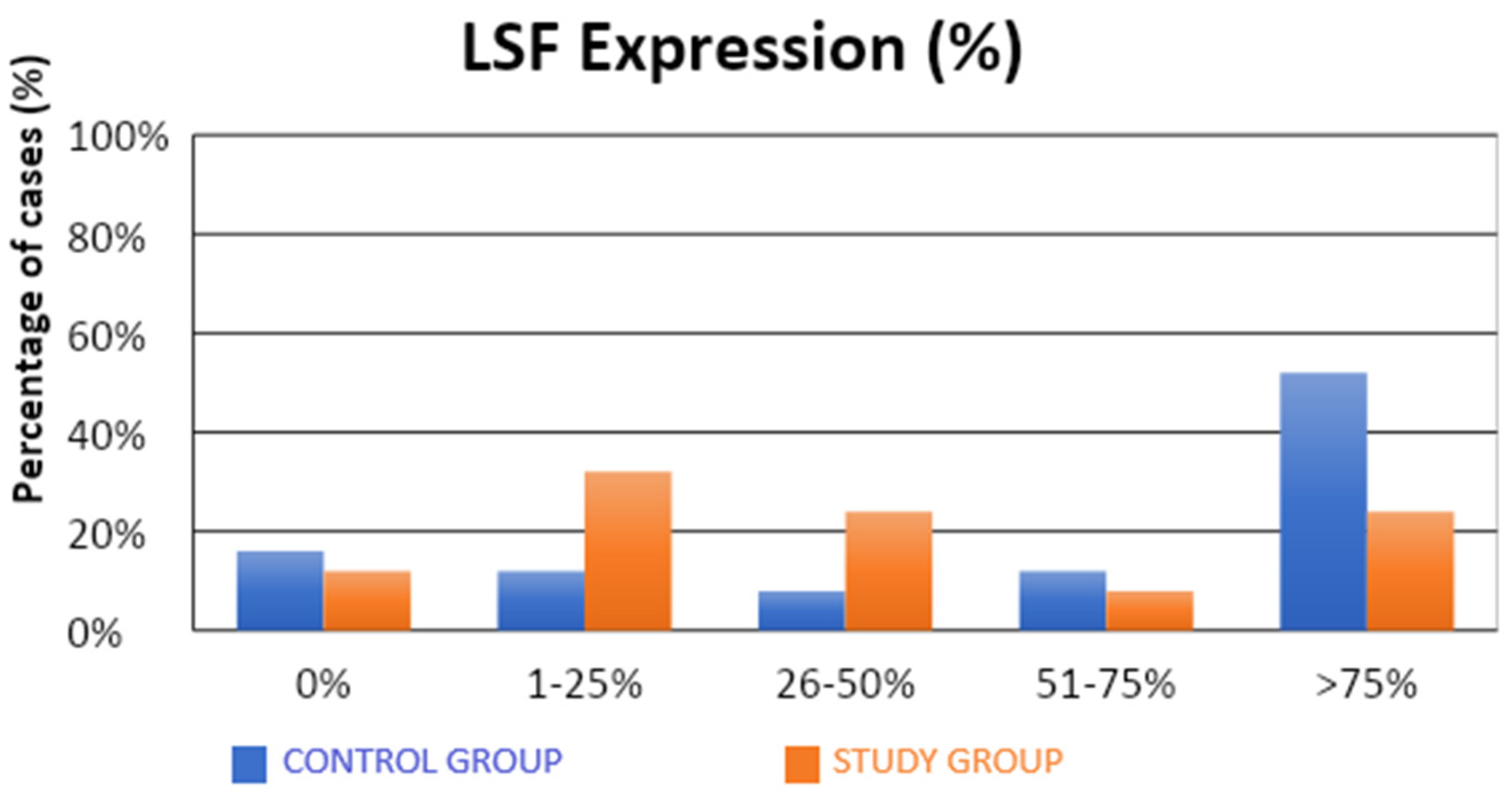


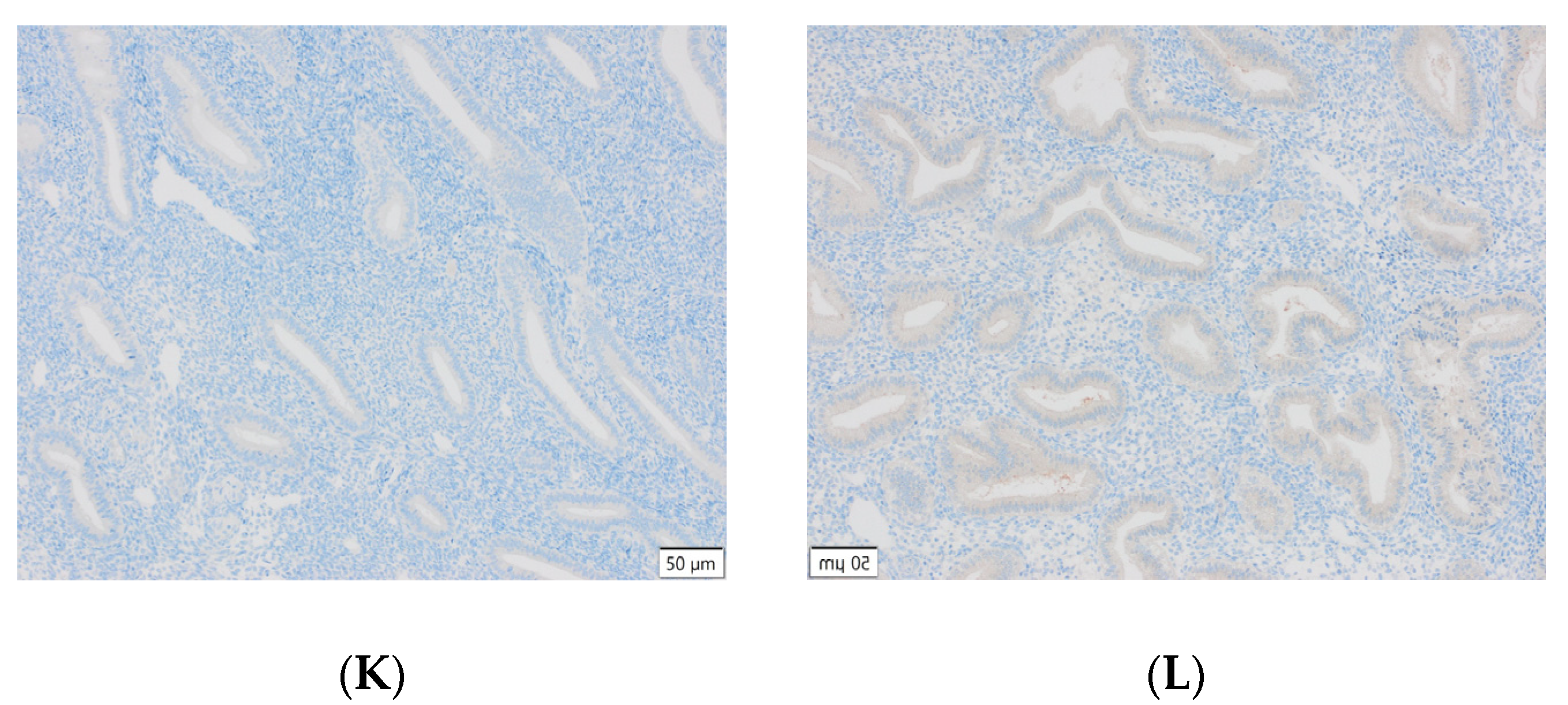

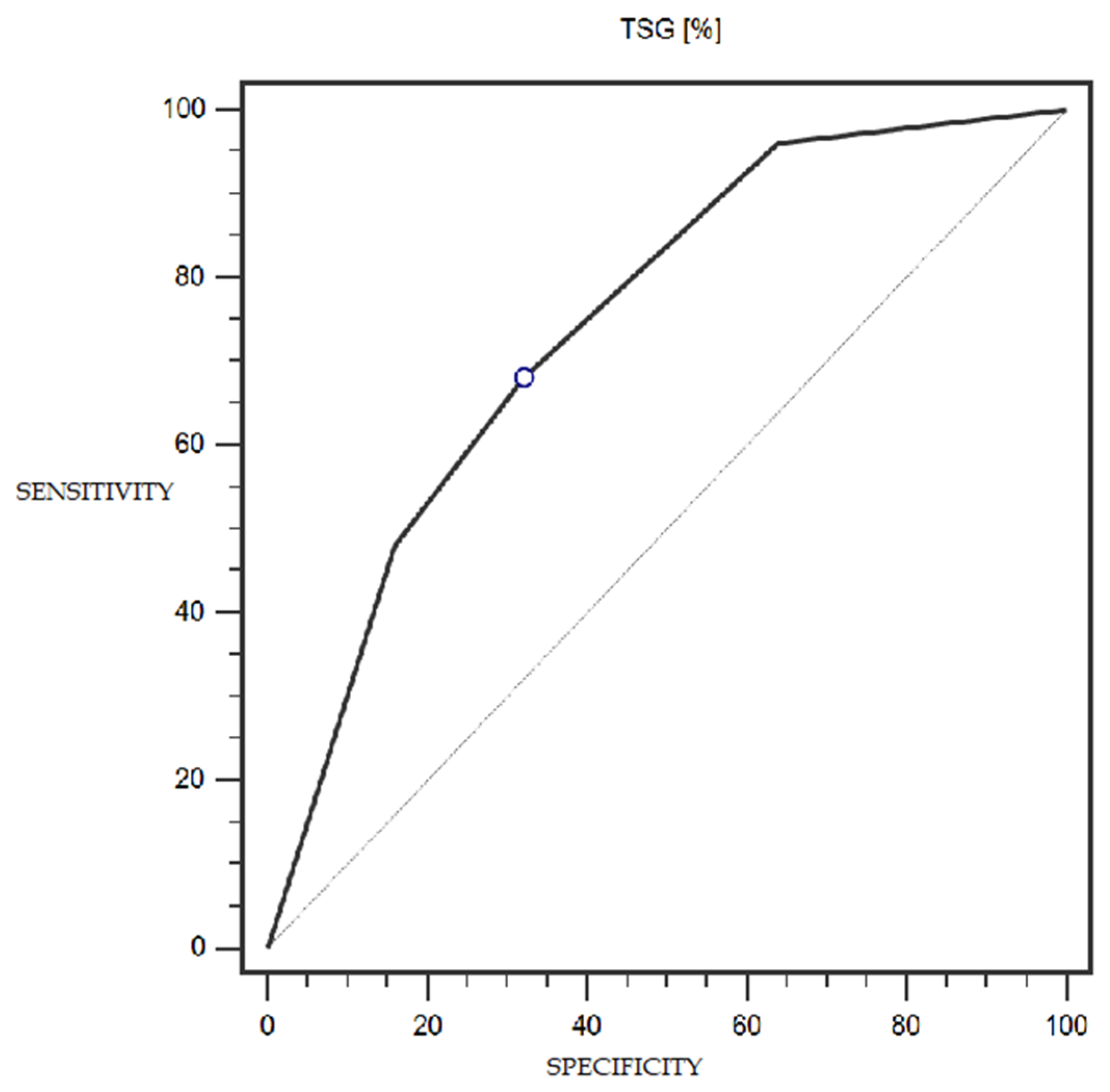

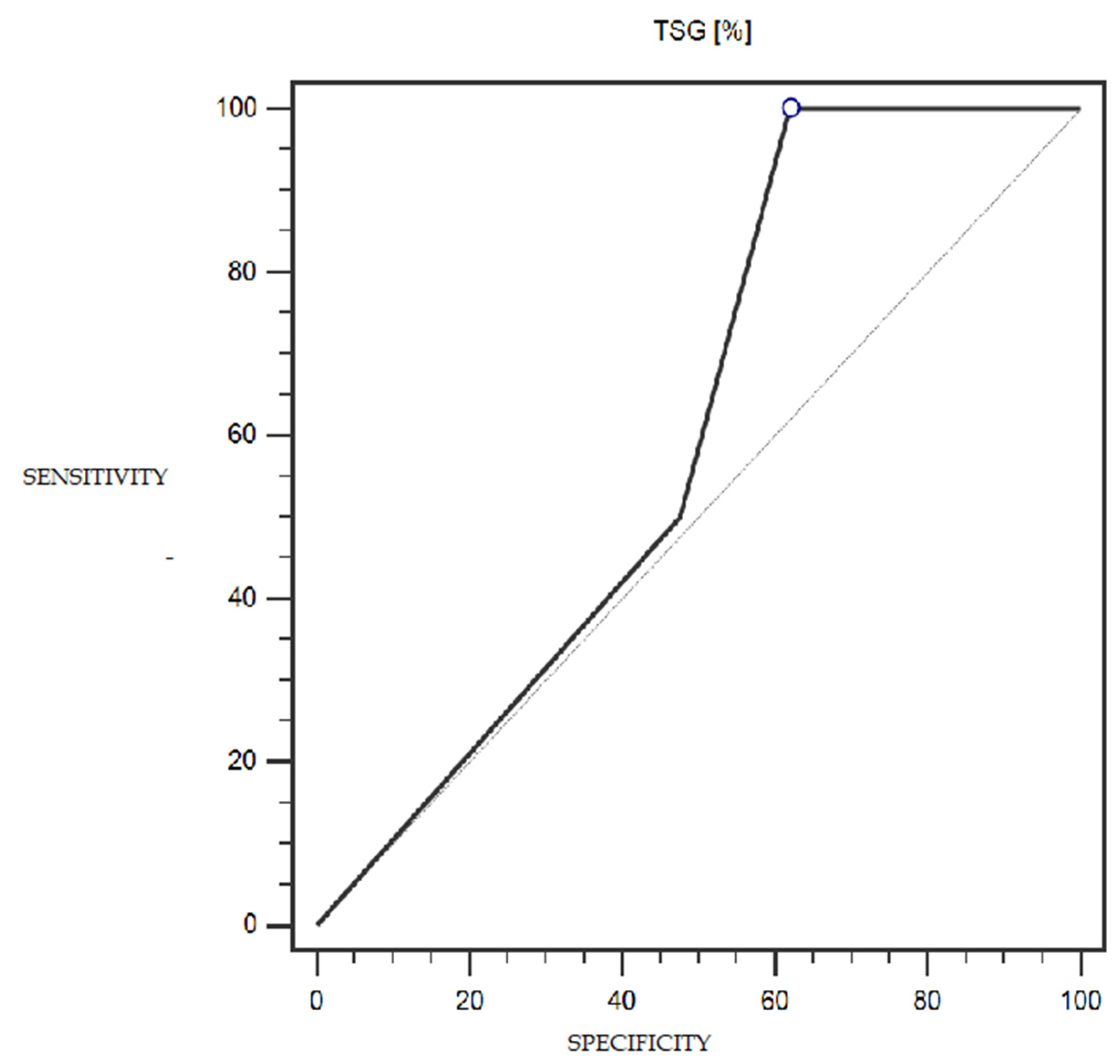
| n (%) a or Mean ± Standard Deviation Median (Interquartile Range) Min–Max b,c | p-Value | ||
|---|---|---|---|
| Control Group | Study Group | ||
| Age (years) | 65 (55.7–70.8) | 68 (58.7–74.2) | 0.2214 |
| Body weight (kg) | 73 ± 13.5 | 73.2 ± 13.3 | 0.9580 |
| BMI (kg/m2) | 27 ± 4.6 | 28 ± 4.9 | 0.4634 |
| Age at first menstruation (years) | 13 (12–14.5) | 14 (13–15) | 0.2582 |
| Pregnancies | 2 (1–3) | 2 (1–2) | 0.7929 |
| Births | 2 (1–2) | 2 (1–2) | 0.7285 |
| Comorbidities—diabetes | 0.4705 | ||
| Yes | - | 4 (8%) | |
| No | 50 (100%) | 46 (92%) | |
| Comorbidities—arterial hypertension | 0.0020 * | ||
| Yes | 4 (8%) | 26 (52%) | |
| No | 46 (92%) | 24 (48%) | |
| TSG | 0.0312 * | ||
| 0% | 8 (16%) | 24 (48%) | |
| <25% | 18 (16%) | 10 (20%) | |
| 25–50% | 6 (12%) | 6 (12%) | |
| 50–75% | 10 (20%) | 8 (16%) | |
| >75% | 18 (36%) | 2 (4%) | |
| LSF 0% <25% 25–50% 50–75% >75% | 8 (16%) 6 (12%) 4 (8%) 6 (12%) 26 (52%) | 6 (12%) 16 (32%) 12 (24%) 4 (8%) 12 (24%) | 0.1260 |
| n (%) a | Normal Data Distribution (Yes/No) | |
|---|---|---|
| Clinical diagnosis (according to ICD-10) C54 | 50 (100%) | - |
| FIGO | ||
| IA IB II IIIB IIIC | 16 (32%) 26 (52%) 2 (4%) 4 (8%) 2 (4%) | No |
| Nodal status | ||
| N− | 46 (92%) | No |
| N+ | 4 (8%) | |
| Histopathological diagnosis | ||
| Endometrial cancer—glandular type | 50 (100%) | - |
| Degree of histopathological malignancy | ||
| G1 | 14 (28%) | Yes |
| G2 | 24 (48%) | |
| G3 | 12 (24%) |
| n (%) | OR (95% CI) p-Value | |||
|---|---|---|---|---|
| Control Group | Study Group | |||
| TSG | 0% ≥1 | 8 (16%) 42 (84%) | 24 (48%) 26 (52%) | 0.21 (0.05–0.78) 0.0197 * |
| 0–25% >25% | 16 (32%) 34 (68%) | 34 (68%) 16 (32%) | 0.22 (0.07–0.73) 0.0129 * | |
| 0–50% >50 | 22 (44%) 28 (56%) | 40 (80%) 10 (20%) | 0.20 (0.06–0.69) 0.0113 * | |
| 0–75 >75% | 32 (64%) 18 (36%) | 48 (96%) 2 (4%) | 0.07 (0.01–0.64) 0.0182 * | |
| LSF | 0% ≥1 | 8 (16%) 42 (84%) | 6 (12%) 44 (88%) | 1.40 (0.28–7.00) 0.6845 |
| 0–25% >25% | 14 (28%) 36 (72%) | 22 (44%) 28 (56%) | 0.49 (0.15–1.61) 0.2416 | |
| 0–50% >50 | 18 (36%) 32 (64%) | 34 (68%) 16 (32%) | 0.26 (0.08–0.85) 0.0262 * | |
| 0–75 >75% | 24 (48%) 26 (52%) | 38 (76%) 12 (24%) | 0.29 (0.09–0.97) 0.0454 * | |
| Cut-Off Point | Sensitivity (%) | Specificity (%) | AUC (95% CI) | p-Value | |
|---|---|---|---|---|---|
| TSG (%) | ≤25% | 68% | 68% | 0.75 (0.60–0.86) | 0.0002 * |
| LSF (%) | ≤25–50% | 68% | 6% | 0.63 (0.48–0.76) | 0.0966 |
| Variable | Cut-Off Point | Sensitivity (%) | Specificity (%) | AUC (95% CI) | p-Value |
|---|---|---|---|---|---|
| TSG (%) | ≤1 | 100% | 38% | 0.61 (0.39–0.79) | 0.3670 |
| LSF (%) | >1 | 100% | 52% | 0.81 (0.60–0.94) | 0.0005 * |
Disclaimer/Publisher’s Note: The statements, opinions and data contained in all publications are solely those of the individual author(s) and contributor(s) and not of MDPI and/or the editor(s). MDPI and/or the editor(s) disclaim responsibility for any injury to people or property resulting from any ideas, methods, instructions or products referred to in the content. |
© 2024 by the authors. Licensee MDPI, Basel, Switzerland. This article is an open access article distributed under the terms and conditions of the Creative Commons Attribution (CC BY) license (https://creativecommons.org/licenses/by/4.0/).
Share and Cite
Ziemiński, R.; Stupak, A.; Kwiatek, M.; Gęca, T.; Warowicka, A.; Hejne, K.; Kwaśniewska, A.; Goździcka-Józefiak, A.; Kwaśniewski, W. Analysis of the Expression of LSF Transcription Factor in the Regulation of Transcription and TSG101 during the Neoplastic Transformation of Endometrial Cells. Cells 2024, 13, 580. https://doi.org/10.3390/cells13070580
Ziemiński R, Stupak A, Kwiatek M, Gęca T, Warowicka A, Hejne K, Kwaśniewska A, Goździcka-Józefiak A, Kwaśniewski W. Analysis of the Expression of LSF Transcription Factor in the Regulation of Transcription and TSG101 during the Neoplastic Transformation of Endometrial Cells. Cells. 2024; 13(7):580. https://doi.org/10.3390/cells13070580
Chicago/Turabian StyleZiemiński, Rafał, Aleksandra Stupak, Maciej Kwiatek, Tomasz Gęca, Alicja Warowicka, Karolina Hejne, Anna Kwaśniewska, Anna Goździcka-Józefiak, and Wojciech Kwaśniewski. 2024. "Analysis of the Expression of LSF Transcription Factor in the Regulation of Transcription and TSG101 during the Neoplastic Transformation of Endometrial Cells" Cells 13, no. 7: 580. https://doi.org/10.3390/cells13070580
APA StyleZiemiński, R., Stupak, A., Kwiatek, M., Gęca, T., Warowicka, A., Hejne, K., Kwaśniewska, A., Goździcka-Józefiak, A., & Kwaśniewski, W. (2024). Analysis of the Expression of LSF Transcription Factor in the Regulation of Transcription and TSG101 during the Neoplastic Transformation of Endometrial Cells. Cells, 13(7), 580. https://doi.org/10.3390/cells13070580







